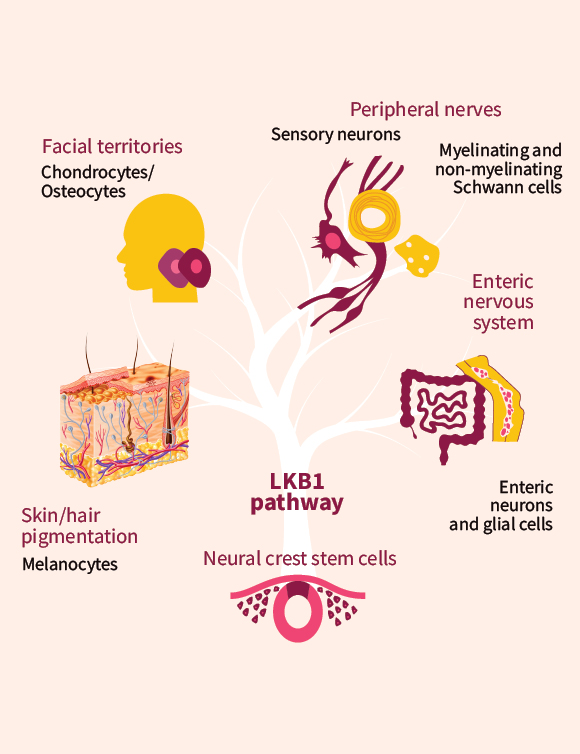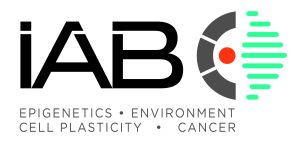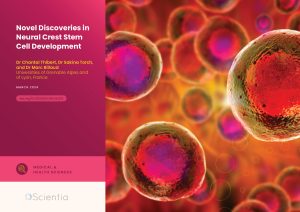Dr Chantal Thibert – Dr Sakina Torch – Dr Marc Billaud | Novel Discoveries in Neural Crest Stem Cell Development
Neural Crest Cells (NCCs) are a population of embryonic stem cells from which a wide range of cell types are generated, including those associated with the development of facial bones, skin pigmentation, and nerves. Drs Chantal Thibert, Sakina Torch, and Marc Billaud have investigated the regulation of NCC formation and differentiation at the Institute for Advanced Biosciences at the University Grenoble Alpes, describing the recently discovered underlying mechanistic processes and how this knowledge can inform the development of novel therapeutic interventions.
Neural Crest Cells: Formation and Function
Neural Crest Cells (NCCs) are vertebrate-specific and mobilise towards various tissues within the developing embryo, where they acquire specialised functionalities. These stem cells originate within the early brain and spinal cord system known as the neural tube and give rise to a plethora of cell lineages under the influence of a complex interplay of gene regulatory networks, signalling pathways, and microenvironmental cues.
Following their specification, NCCs separate from the neural tube and begin dividing and migrating towards their target tissues, where they have a critical role in the establishment of cellular expansion and function, and the maintenance of homeostasis. NCCs contribute to the formation of facial structures (including bones, and muscles), skin pigmentation, peripheral nerves, and the nervous system controlling digestive motility. Once established, specialised NCC populations are conserved throughout all developmental stages until adulthood. Defective NCC formation and maintenance is implicated in a wide range of debilitating human conditions, including physical malformations and cancers.
Emerging Contributions of the Metabolic Regulator LKB1
A wide range of developmental activities, including cell survival, cell division, cell polarity (i.e., spatial differences in shape, structure, and function within a cell), and energy metabolism, are modulated by a regulatory enzyme called LKB1.
Recently, LKB1 has emerged as a master driver of NCC lineages, a discovery propelled by the research of Drs Chantal Thibert, Sakina Torch and Marc Billaud of the Institute for Advanced Biosciences at University Grenoble Alpes, France. Recently, they published a comprehensive review of their work along with studies others have conducted into the role of LKB1 in the formation and maintenance of NCC derivatives. They report that LKB1 is essential in governing various processes underpinning the development of several NCC populations and suggest that increasing our understanding of these pathways may drive new therapeutic strategies to treat serious NCC-associated disorders.
Genetic Ablation of LKB1
The critical contribution of LKB1 signalling in NCC development and maintenance was first hypothesised on the basis of pioneering molecular manipulation studies. Indeed, LKB1 gene inactivation from the beginning of embryonic development led to serious developmental defects and fatalities in the mouse. However, the early embryonic lethality observed prevented further analysis regarding the impact on embryonic development over time. This led to the generation of genetically engineered animal models, allowing for gene ablation at specific times during NCC formation, either before NCC migration or after their migration toward their target tissues. In-depth phenotyping of these models has since facilitated the identification of LKB1 as an important regulator of NCC lineage formation and maintenance.

The neural crest cells are fascinating stem cells that migrate through the embryo, colonising various organs and giving rise to numerous derivatives. Recently, the signaling pathway involving the kinase and metabolic regulator LKB1 has been found to play a crucial role in several neural crest cell lineages. These include melanocytes in skin, chondrocytes, and osteocytes in facial territories, as well as neurons and glial cells of the peripheral nervous system, including peripheral nerves, and the enteric nervous system responsible for digestive motility.
Role of LKB1 in Melanocytes and Skin Pigmentation
Melanocytes arising from NCCs contribute to the synthesis of melanin, which is responsible for pigmentation in skin and hair cells. By inactivating LKB1 in post-migratory NCC subsets, Dr Thibert and her colleagues discovered that mutant mice were born with decreased melanocyte numbers, leading to coat depigmentation. However, inactivating LKB1 in melanocytes of newborn pups did not result in skin or hair colour defects, implying that LKB1 has a crucial role in melanocyte formation, although it is not required for their maintenance after birth.
Besides coat pigmentation defects, most of the mice with Lkb1 ablation in post-migratory NCCs failed to thrive and died after only a few weeks, leading the researchers to explore LKB1 functions in other neural crest derivatives.
LKB1 Functions in Peripheral Nerves
The optimal growth and maturation of nerve cell systems depends on LKB1, as shown during the specification of
a group of electrical signal conductors called Schwann cells. Defects arising from the elimination of LKB1 in mouse Schwann cell precursors included progressive nerve damage and degeneration associated with signs of peripheral neuropathy and posterior paralysis. Inactivating LKB1 at later stages resulted in stunted growth, muscle wastage, and premature death.
There is currently only limited evidence available regarding the metabolic requirements of NCC formation, but Dr Thibert and associates have confirmed that stem cell specialisation requires energy metabolism. They observed significantly decreased glucose levels in the nerve cells of LKB1-deficient animal models, and revealed potential novel mechanisms notably involving the biosynthesis of some amino acids via which LKB1 modulates tissue-specific metabolic activity.
Digestive tract health is regulated by a specialised nervous network of cells lining the gut, which interact with the digestive epithelium and smooth muscles, the immune system and the immediate microbial environment to promote nutrient absorption and modulate bowel movements. Defects within this intricate nervous system can lead to muscle dysfunctions, resulting in loss of digestive tract motility and pseudo-obstruction, with a concomitant reduction in quality of life. The importance of LKB1 signalling in the maintenance of the nervous system of the digestive system was discovered for the first time by Dr Thibert and associates, whereby progressive cellular degeneration occurred postnatally following inactivation of LKB1 during murine embryonic development.
Essential contribution of LKB1 in head formation
Although the exact molecular mechanisms underpinning LKB1/NCC interactions remain largely elusive, Drs Thibert, Torch, and Billaud have identified components via which LKB1 modulates chick and mouse head structure. Elegant experiments showed that LKB1 is indeed indispensable for certain NCC-mediated craniofacial structures, and their in-depth review pinpointed several downstream effectors involved in the formation and preservation of cranial NCCs.
The Pursuit of Medical Advancement
Heterozygous germline mutations in the LKB1 gene (STK11 in humans) are responsible for the inherited Peutz-Jeghers cancer syndrome. Somatic loss-of-function mutations in the LKB1 tumour suppressor are also identified in various malignancies, such as non-small cell lung and cervical cancers. However, germline LKB1 mutations do not appear linked to neural crest syndromes, likely because homozygous mutations would be embryonic lethal. Considering LKB1’s crucial roles in NCC development, it is reasonable to suggest that hypomorphic alterations affecting LKB1 activity or its associated signalling pathways could potentially contribute to the onset of NCC disorders.
Currently, available treatment options for patients suffering from malformations caused by NCC disorders are mainly limited to corrective surgery. Increasing our understanding of the causative mechanisms of defective NCC formation, particularly through tailored spatiotemporal in vivo approaches, may aid in the design of novel therapeutic interventions to improve both patient experience and clinical outcomes.
To this end, further exploration of LKB1 functions within various NCC populations, the identification of additional LKB1 regulatory factors and effectors, and the elucidation of their role in signalling interplays associated with human pathologies are required. Without a doubt, Dr Thibert and her collaborators will continue to dissect LKB1 functions in NCCs that could be beneficial in their quest to relieve individuals of the devastating effects of these challenging diseases.
SHARE
DOWNLOAD E-BOOK
REFERENCE
https://doi.org/10.33548/SCIENTIA1012
MEET THE RESEARCHER

Dr Chantal Thibert,
University Grenoble Alpes,
France

Dr Marc Billaud,
University of Lyon,
France

Dr Sakina Torch,
University Grenoble Alpes,
France
Dr Chantal Thibert received her PhD in molecular genetics at Lyon University and currently holds the position of senior researcher at the French National Center for Scientific Research (CNRS). She leads a research group at the Institute for Advanced Biosciences, University Grenoble Alpes (INSERM U1209, CNRS UMR5309), where they focus on studying
how metabolic regulations contribute to development
and diseases.
Dr Sakina Torch has been working alongside Dr Thibert at the Institute for Advanced Biosciences for several years. She holds a PhD in cellular and molecular biology and holds a research/lecturer position at the University Grenoble Alpes.
Dr Marc Billaud, also a senior researcher at CNRS, completed his PhD in cellular and molecular biology. He previously led a research group at the Institute for Advanced Biosciences, where he, along with Dr Sakina Torch, initiated the exploration of LKB1 functions in neural crest cells. He now holds his current position at the Lyon Cancer Research Center, where he established a research department in human and social sciences.
Together, Drs Thibert, Torch, and Billaud have published nearly 150 articles and remain actively engaged in teaching, supervision, and board activities. They continue their
close collaboration on various projects and share a deep passion for promoting and popularising science within the wider community.
CONTACT
chantal.thibert@univ-grenoble-alpes.fr
FUNDING
Association pour la Recherche sur le Cancer, Grant/Award Numbers:
Doctoral fellowship, R20133CC
IRS-IDEX-University Grenoble Alpes, Grant/Award Number: PhenoCrest ANR-15-IDEX-02
LIGUE régionale contre le Cancer, Grant/Award Number: R20003CC
UGA-CBH Graduate school (EUR, IDEX) Doctoral fellowship ANR-17-EURE-0003
FURTHER READING
C Thibert, A Lucas, M Billaud, et al., Functions of LKB1 in neural crest development: The story unfolds, Developmental Dynamics, 252(8), 1077–1095. DOI: https://doi.org/10.1002/dvdy.581


REPUBLISH OUR ARTICLES
We encourage all formats of sharing and republishing of our articles. Whether you want to host on your website, publication or blog, we welcome this. Find out more
Creative Commons Licence (CC BY 4.0)
This work is licensed under a Creative Commons Attribution 4.0 International License. 
What does this mean?
Share: You can copy and redistribute the material in any medium or format
Adapt: You can change, and build upon the material for any purpose, even commercially.
Credit: You must give appropriate credit, provide a link to the license, and indicate if changes were made.
SUBSCRIBE NOW
Follow Us
MORE ARTICLES YOU MAY LIKE
Dr Ralf Adam | New Technologies Shaping the Future of Oral Hygiene
Understanding the efficiency of various toothbrush technologies is essential for achieving optimal oral health. Dr Ralf Adam, who leads a dedicated team at Procter & Gamble in Germany, is keen to investigate the complexities of these technologies. His team have provided new insights into the best toothbrush types for plaque removal and the maintenance of gum health. By highlighting the importance of informed oral care decisions and ongoing investigations, this vital research works towards ensuring everyone can achieve a brighter, healthier smile.
Dr Toby Phesse | Revealing the Mysteries of Wnt Signalling: Novel Approaches to Beating Cancer
Cancer remains a leading cause of mortality worldwide, and the need for new, more effective treatments remains an urgent challenge. Dr Toby Phesse from Cardiff University in the UK focuses on the role of the Wnt receptor found on the surface of cells and its involvement with cell communication and cancer growth, bringing fresh hopes for new therapeutic options.
Dr Vijay Reddy | The Virus World Database: An Invaluable Resource for Public Health and Healthcare
Severe viral disease presents an ongoing challenge to the health of humankind. While unparalleled developments in science and technology are improving our understanding of such viruses, this information needs to be readily accessible to researchers to ensure continued progress in public health and healthcare. Dr Vijay Reddy and his colleagues at the Hormel Institute (University of Minnesota) developed the Virus World database, an invaluable resource that details the genome, structure, and host of practically every discovered virus to date.
Professor Ralf Herwig | Deciphering the Enigma of Vitamin D and the Immune System
Vitamin D has been studied as a treatment for a large number of diseases and conditions, from cancer to autism to COVID-19. However, its mode of action is not completely understood. Professor Ralf Herwig carries out his research at HG Pharma GmbH (Austria) and Ulster University (UK). His vital work explores the role of vitamin D in the body with a view to unlocking its potential as a treatment for a variety of health conditions involving the immune system.





